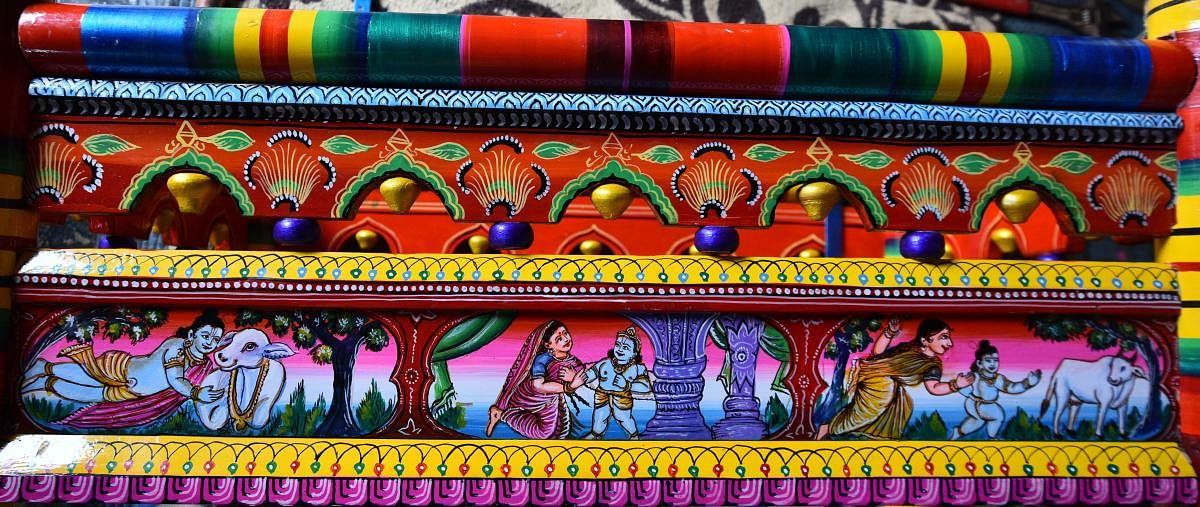The colourful wooden cradles of Kalaghatagi have nurtured generations of children in the Dharwad region. But nearly a decade back, this unique craft of cradle-making, which ruled the town for 400 years, started fading away due to a lack of demand and patronage.
The slump in demand meant there were just two families in the town involved in the craft. The artists and artisans traditionally involved in the profession looked for other jobs and the younger generation no longer wanted to continue with the craft.
Now the Kalaghatagi cradles are getting a fresh lease of life, thanks to coverage in the media and the efforts of a few families who have kept the art going despite the hurdles thrown at them.
42-year-old Maruti Badiger’s family has been into cradle-making for the last six generations. They say their ancestors made cradles for the royal families and received their appreciation.
A few years back, Maruti admits he felt like giving up the family craft and taking up another job. But despite the reduced demand, Maruti kept going, inspired by the artistry of his grandfather Omkarappa Badiger and brother Gurunath.
Fortunes of the struggling cradle-making families began turning nearly two years back, when the Kannada actor Dr Rajkumar’s family ordered a Kalaghatagi cradle for the child of one of their relatives.
When the news spread, the artisans began getting more enquiries and orders. Many influential people and celebrities began taking these cradles to other states and even abroad helping revive the art.
Today, the Badiger family has so many work orders that his wife, daughters and mother have to help him meet the demand. Maruti has also asked other artisans to lend a helping hand and has been training the younger generation as well.
“I feel happy that my family did not give up our tradition of cradle-making, which is the identity of Kalaghatagi. Though we had to suffer during Covid-19 lockdown due to unavailability of raw materials and orders, demand for cradles has returned,” says Maruti.
Safe colours
Despite a variety of cradles being available in the market, Kalaghatagi cradles have their own charm. They are known for their quality of the build and masterly art. The artisans claim that these cradles can last at least 100 years, something proved by the fact that they keep getting old cradles for repainting.
The 31X21 inch cradles are made using teak wood, known for its durability.
Once the base is ready, they paint the cradles using colours mixed with natural materials like lac, wax, paste of tamarind seeds and clay, so the child does not suffer any allergy or infection.
The four sides of the cradles are then adorned with paintings depicting the mythological episodes of the Krishna Leela, Ramayana, Mahabharata, Shiva-Parvathi, apart from scenes of animals as they believe that such pictures lead children to imbibe moral values.
Now, to meet the demand of all the communities, paintings of Mahaveera, Christ, Mecca or even a picture provided by a user are painted onto it.
Earlier, they prepared hanging cradles, but now the cradles are made with a stand, which is much more mobile.
They fit bearings to the cradle in such a way that it gives the baby a sound sleep.
While the hanging cradles cost somewhere between Rs 20,000 and 25,000 and take a month-and-a-half to prepare, the cradles with a stand cost around Rs 80,000 to one lakh and take three months to be ready. Once the cradles are ready, pooja is offered to it before delivering it to the customers.
Apart from these cradles, the artisans make smaller cradles called ‘Harake tottilu’ as well as cradles used during festivals like Janmashtami, Mahaveer Jayanthi and Hanuman Jayanthi.
They also make sofa sets, palanquins, idols of goddesses and swings with similar art but it is their cradles that are the most sought-after.
The rising cost of raw materials, mainly wood and the intricate art involved makes the cradle expensive but owning a Kalaghatagi cradle is akin to owning an antique art piece, which is peerless even today.
